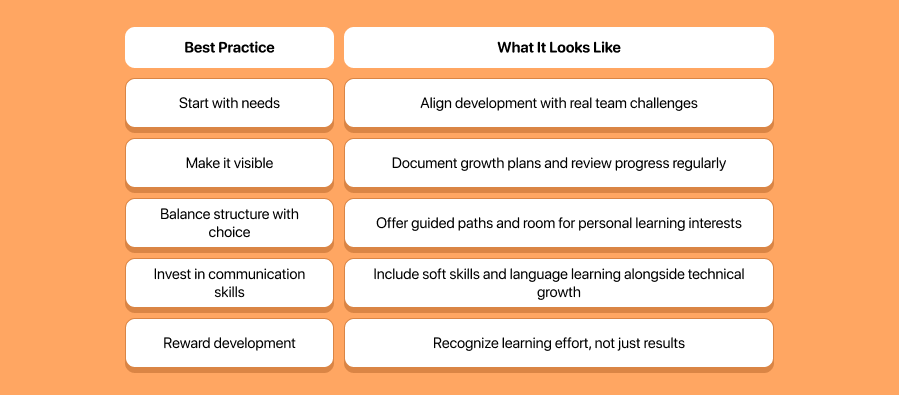In fast-moving workplaces, it’s easy to focus on hiring the next great candidate. But the truth is, your most valuable potential often sits right in front of you—on your team. Investing in your employees' growth isn’t just good for them. It’s one of the most effective ways to future-proof your business.
Employee development is more than just training sessions and upskilling checklists. It’s a mindset: build people, and the company grows with them.
Why Employee Development Deserves More Attention
Companies that prioritize employee training and development tend to:
- Attract more ambitious candidates
- Reduce turnover rates significantly
- Build stronger internal pipelines for leadership roles
- Stay more adaptable during industry shifts
Building a Real Development Culture
So, how to develop employees in a way that sticks? It starts with a shift in culture: development needs to be seen as a daily part of work, not an occasional workshop.
Step 1: Define Clear Growth Paths
Start with clarity. Employees need to understand where they can go within the organization.
Each development plan should answer:
- What future roles or skills are relevant to this employee?
- What competencies are needed to get there?
- What resources, support, or mentorship will be offered?
Even early-career team members become more motivated when they see their path forward.
Step 2: Focus on Purposeful, Relevant Learning
Avoid generic or excessive training. Learning should be practical and goal-driven.
Include a mix of:
- Technical skills specific to the job
- Soft skills like communication and leadership
- Strategic thinking
- Language learning and intercultural skills (especially in global teams)
Choose resources that employees can apply in real situations, not just theory.
Step 3: Build Learning Into the Workflow
Training should enhance everyday work, not interrupt it.
Effective approaches include:
- Mentorship and peer learning
- Cross-team projects that stretch skills
- Just-in-time content or microlearning
- Feedback-based learning on live tasks
When learning becomes part of the routine, it feels natural and more effective.
Step 4: Track Progress and Give Feedback
Development isn’t “set and forget.” Employees need to know how they’re doing.
Use regular one-on-one check-ins to:
- Review learning goals
- Adjust plans as roles evolve
- Celebrate growth or course-correct if needed
This builds trust and keeps learning aligned with performance.
Step 5: Create Opportunities for Growth to Show Up
Development should lead somewhere: to more responsibility, recognition, or a new challenge.
Consider offering:
- Temporary project leadership
- A chance to present at meetings
- Involvement in strategic decisions
- Internal job mobility
When growth is visible, employees stay engaged, and others feel inspired to grow too.
Developing for the Global Workplace
One major area often overlooked in development plans is language, and it matters more than ever. If your company interacts with international clients, remote teams, or global suppliers, language fluency is a competitive advantage.
Here’s where corporate language learning fits directly into development:

Language training should be personalized, flexible, and tied to real work goals. EWA offers exactly that: English learning that employees can use right away, with progress that’s easy to track for both learners and managers.
By integrating language into your broader employee development plan, you support access, equity, and global readiness.
From Individual Growth to Collective Impact
When thinking about how to train and develop employees, don’t start with courses. Start with curiosity.
- What does each person want to become?
- What challenges is your team likely to face in the next 6–12 months?
- What skills will create momentum, not just for individuals, but for the company as a whole?
Make development personal, relevant, and consistent.
Best Practices That Keep Development On Track
These are the best practices that will keep your employee development strategy grounded and effective:

You can build a stronger company from the inside out. By creating space for people to grow in skills, in language, and confidence, you unlock potential that’s already there. Developing employees for future success means treating growth as part of the job, not a bonus. It’s a long-term investment. But it pays off in loyalty, agility, and the kind of team that’s ready for anything.
FAQ
1. How can small companies implement employee development without big budgets?
You don’t need a massive L&D department to support growth. Smaller companies can focus on mentorship, cross-training, access to free or low-cost online learning platforms, and regular feedback sessions. Even something as simple as giving an employee time each week to learn a new tool or skill can make a meaningful difference.
2. What’s the difference between employee development and employee training?
Training is typically short-term and task-specific, for example, learning to use a new CRM. Development is broader and future-oriented. It includes soft skills, leadership, and career growth. In practice, the two work best together: training builds immediate competence, development builds long-term capability.
3. When should language training be introduced as part of development?
Language learning is most effective when tied to a real need, such as preparing for international collaboration, a promotion, or client-facing work. Don’t wait until there’s a communication breakdown. If your business operates globally or plans to expand, language training should be part of your development offering from the start.
















